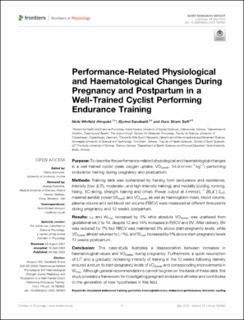| dc.description.abstract | Purpose: To describe the performance-related physiological and haematological changes in a well-trained cyclist (peak oxygen uptake, VO2peak: 54.9 ml min−1 ·kg−1 ) performing endurance training during pregnancy and postpartum.
Methods: Training data was systemized by training form (endurance and resistance), intensity (low- (LIT), moderate-, and high-intensity training), and modality (cycling, running, hiking, XC-skiing, strength training and other). Power output at 4 mmol L−1 [BLa− ] (L4), maximal aerobic power (Wmax), and VO2peak as well as haemoglobin mass, blood volume, plasma volume and red blood cell volume (RBCV) were measured at different time points during pregnancy and 12 weeks postpartum.
Results: L4 and Wmax increased by 3% while absolute VO2peak was unaltered from gestational wk 2 to 14, despite 12 and 14% increases in RBCV and BV. After delivery, BV was reduced by 7% but RBCV was maintained 5% above start-pregnancy levels, while VO2peak almost returned to (-1%), and Wmax increased by 5% above start-pregnancy levels 12 weeks postpartum.
Conclusion: This case-study illustrates a disassociation between increases in haematological values and VO2peak during pregnancy. Furthermore, a quick resumption of LIT and a gradually increasing intensity of training in the 12 weeks following delivery ensured a return to start-pregnancy levels of VO2peak and corresponding improvements in Wmax. Although general recommendations cannot be given on the basis of these data, this study provides a framework for investigating pregnant endurance athletes and contributes to the generation of new hypotheses in this field. | en_US |

